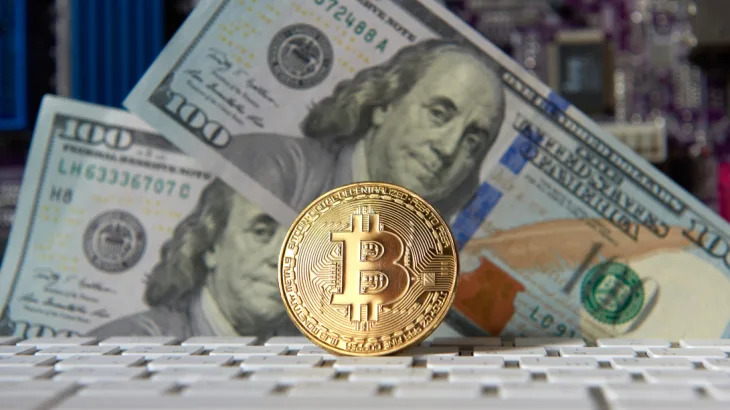(Bloomberg) -- To Michael Saylor’s online fanbase, it’s the next step in the great normalization of crypto: Bitcoin proxy MicroStrategy Inc. enters the S&P 500 next year, forcing the likes of index-tracking funds to buy his controversial company en masse. Whether they like it or not.
As MicroStrategy officially joins the Nasdaq 100 on Monday, after comfortably meeting all thresholds for inclusion, the dot-com-era software maker turned leveraged Bitcoin play is on a tear. Thanks to its relentless crypto-buying program, the firm is enjoying a 480% rally in its stock price this year, fetching a market-capitalization heft that’s on par with some of the biggest companies in America.
Now Saylor is setting his sights on S&P 500 inclusion — even if Wall Street sees it as a long shot — emboldened by a change in accounting rules relating to digital assets, a change that could help it clear an earnings hurdle next year.
“I’m optimistic in 2025 when we adopt fair value accounting, when we end up with $50 billion of assets on our balance sheet,” Saylor told Bloomberg TV last week. “Under fair value, if Bitcoin goes up 20% a year, you’re looking at $10 billion a year of investment income,” he added. “And I think that is the final thing people are looking for, for an inclusion in the S&P.”
It will be far from easy. Meeting all eligibility criteria doesn’t guarantee an immediate spot, given the discretion that the index committee at S&P Dow Jones Indices tend to exercise when it comes to member changes. MicroStrategy’s big gamble on Bitcoin and the already heavy presence of technology companies are big potential drawbacks.
Yet for all that, Saylor continues to confound his doubters. Chalk it up to the frenetic rally in the world’s largest cryptocurrency and the slow but sure acceptance of the digital asset class on Wall Street. The question is whether prized entry into the the world’s most-watched stock index is a bridge too far.
Saylor’s “Bitcoin Treasury” strategy — selling bonds and equities to buy and hold the token — has made him a hero among crypto bulls, putting his $89 billion firm in ranks of the 100 largest companies in the S&P 500. The boom comes even as revenues, mostly derived from its software business, have stagnated near $470 million in the past five years.
While the stock’s market cap and trading volume easily cross the threshold, it has yet to meet the key earnings criteria from S&P: Positive income in the most recent quarter and during a stretch of four quarters.
That roadblock is set to be removed because of a new accounting rule that allows companies to hold digital assets on their balance sheet and record changes in their fair value in net income. Given Bitcoin’s record-setting rally of late, Saylor sees huge gains on the horizon.
Mark Palmer, an analyst at Benchmark Co., for one, agrees. He projects a one-off “multi-billion-dollar boost” to the firm’s first-quarter net income after a rally in its Bitcoin holdings.
“If that net income gain proves sufficient to produce a positive trailing 12-month figure when combined with the MSTR’s losses during the prior three quarters,” he wrote in a note last week. “Then the company will have met the criteria for inclusion in the S&P 500 ahead of the index’s second rebalancing of 2025.”
A S&P spokesperson declined to comment and instead referred inquiries to the index methodology.
It’s not so simple, of course. The role of investment assets is key, according to Antti Petajisto, head of equities at Brooklyn Investment Group. Existing S&P 500 members that own significant investment assets, such as Texas Pacific Land Corp., actively select and manage their holdings and generate sales from related services. Yet per Petajisto, with MicroStrategy now being essentially a Bitcoin holding company, adding the stock would be almost like adding iShares Bitcoin Trust ETF to an equity index.
“As much as I like Bitcoin and Saylor, it is a bit funny that his firm is treated like a regular company,” Petajisto said. “S&P excludes ETFs and closed-end funds from its index because they want the index to contain operating businesses, not investment funds.”
MicroStrategy’s odds to join the S&P 500 are lower than Coinbase Global Inc., according to Kaasha Saini, head of index strategy at Jefferies Financial Group Inc. The largest US crypto exchange also meets eligibility criteria but belongs to the financial industry — a cohort that’s less represented in the S&P 500 than tech, a sector that houses Saylor’s firm.
Meanwhile, MicroStrategy was booted from the S&P SmallCap 600 index back in 2021, underscoring how the all-or-nothing decision is at the behest of a small group of index overseers.
“It was one of the rare occasions that we saw the committee announce a discretionary removal of a constituent that wasn’t among the smallest by market cap,” Saini said. “We don’t rule out possibility of the committee being patient and assessing whether to treat it as an alternative,” she added. “If the committee were to opt to add crypto exposure, we think COIN is a good candidate.”
Even if MicroStrategy meets the eligibility criteria, S&P may choose to wait for a quarter or two before adding it, as was the case with Tesla Inc., according to Edward Yoon, an index strategist at Macquarie Capital.
Meanwhile, there is another qualified candidate that boasts a bigger market value — AppLovin Corp., a provider of marketing services to mobile app developers.
The index committee “don’t want to get into a situation where a company has a risk of being demoted immediately after joining,” Yoon said. “It’s very hard to predict whether MicroStrategy will be picked given the huge volatility.”
--With assistance from Katie Greifeld, Sonali Basak and Isabelle Lee.





